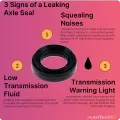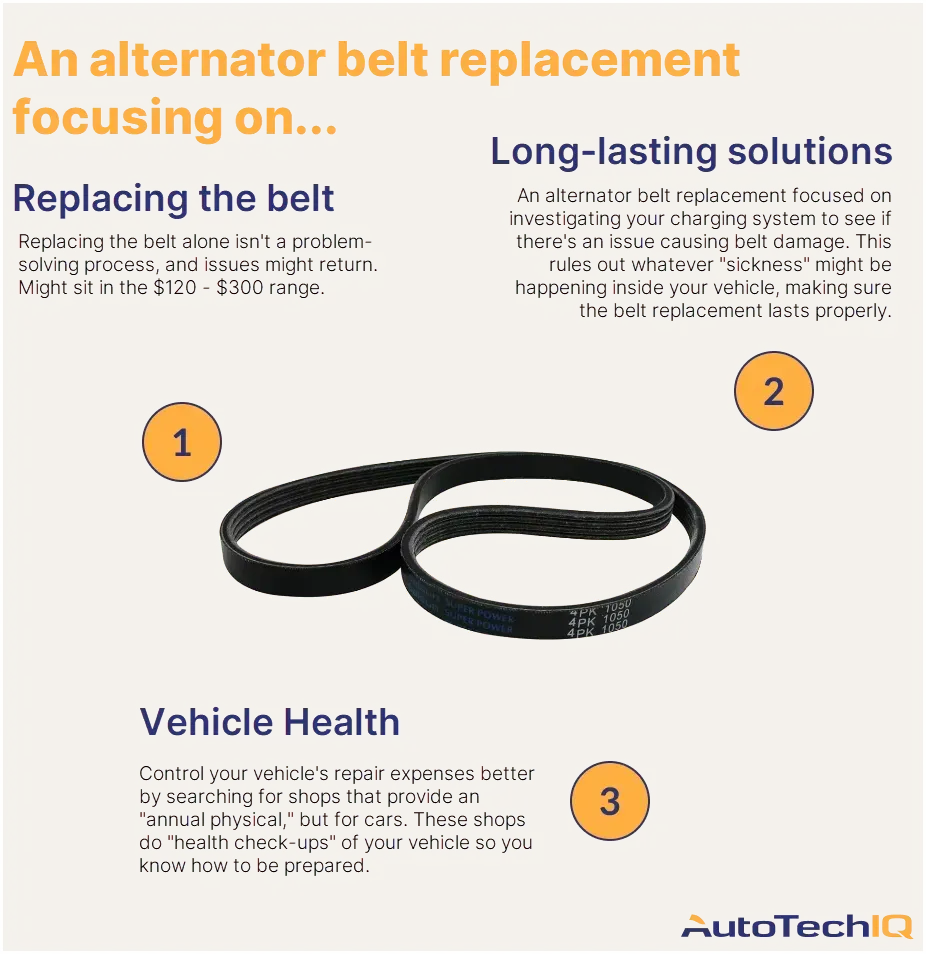
The average cost for an alternator/serpentine belt replacement is between $140 to $300 for non-European car brands like Chevrolet, Toyota, Ford, etc.
For other vehicle models though, like a 2023 Chevrolet Camaro, the range can start at $230. These prices might give you an idea of the range, but the question remains: what caused the serpentine belt to go bad? Let’s see how the answer to this question can affect the service price.
Alternator belt replacement cost: What affects the final price?
There are two ways a shop can quote you on alternator belt replacement service. The first is if you only ask them to replace the serpentine belt. The second is if you ask for a fix to prevent the problem from returning and investigate how serious it is.
Here are the common costs if you ask only for an alternator belt replacement:
-
The labor rate: Labor rates change between professionals (ASE technicians charge more than rookie mechanics), and regional wage differences.
-
The shop’s neighborhood/area: Areas will determine the replacement cost. For example, Santa Barbara in California has different prices than Albuquerque, in New Mexico; this could be due to lease rates, cost of living, etc.
-
The vehicle type: European brands like Mercedes, BMW, Audi, etc., have different prices for alternator belt replacement. For example, an Audi alternator belt replacement can typically start at $250, based on online estimates.
How does replacing the alternator belt return my vehicle to healthy conditions?
If your serpentine belt went faulty because of common wear, meaning nothing else was forcefully damaging it, a serpentine belt replacement returns the vehicle to good working condition.
But, you can’t be sure if your vehicle stays healthy after replacing the serpentine belt without at least a charging system inspection. What if the belt fails again for the same reason? The inspection gives mechanics the confirmation whether only a serpentine belt replacement takes care of everything, or if a deeper process is needed.
The charging system is the serpentine belt’s department, where it works and interacts with different components. Therefore, the charging system is the “scene” where mechanics investigate any deeper related problem.
What exactly is a charging system inspection?
The charging system inspection is a paid “detective work” where mechanics note and record everything that’s not working as expected in your charging system.
-
Mechanics inspect the vehicle, noting everything about the serpentine belt’s performance, and searching for any issue damaging it. The techs focus on looking for belt alignment, pulley condition, and tensioning devices.
-
They show you their observations and propose suggested repairs to get the serpentine belt working 100%.
-
They do a quote for the suggested repairs.
The proposed repair after the inspection might be just a serpentine belt replacement if nothing else was causing damage. But, if the main problem is not just normal wear and involves other systems, the suggested quote offers a complete solution.
Here are the routes you can go based on your options.
-
Alternator belt replacement: This means you want the alternator belt replacement and nothing else, so you’ll probably only pay for common replacement costs. The downside is that you might not discover what caused the belt to go bad in the first place. Assume there’s a problem somewhere else in your car that’s damaging the belt. In this situation, a replacement won’t solve the issue; it might just make you return to the shop soon for another one.
-
Long-lasting fix: This means you want to permanently fix your vehicle and understand what might be wrong with it. So, you want to investigate if there’s an issue causing your alternator belt to wear down faster than expected, and if there is, you want to eliminate it. You’re willing to spend more money to cover extra processes that ensure your car runs reliably for good.
Why have a long-lasting fix? The short answer is to save money and stress while ensuring the vehicle is good for the next thousands of miles. A long-lasting fix has the goal of not having you return to the shop for a really long time.
If the alternator belt problem is being caused by something else, replacing it is like painting over mold.
How much can a long-lasting alternator belt fix cost?
A long-lasting fix has factors changing the final price. Here’s what you can expect:
-
Charging system inspection: A charging system inspection can cost around $120 to $150, but it varies depending on the vehicle's system design. This is an investigation of your charging system including the labor of service advisors and mechanics to discover issues/due repairs around the serpentine belt, alternator, battery, etc.
-
Component replacements: The inspection might indicate other worn components in the charging system that require replacement, increasing the suggested quote. For example, pulleys, idler pulleys, belt tensioners, or other components might be affecting the belt alignment and require replacement.
-
Other systems repairs: The shop might find other malfunctioning systems requiring parts replacements and/or computer reprogramming, affecting the cost range. For example, replacing a faulty battery, alternator, and wiring because they’re stressing the serpentine belt can add more costs to the final quote. In worst cases, the complete suggested quote can go north of $2000.
How to get transparent long-lasting repairs
If you want to:
-
Investigate your faulty alternator belt: Discover if something is damaging it and risking the electrical and charging systems.
-
Fix the whole problem: If something damages the electrical and charging systems, fix it so it doesn’t return anytime soon.
-
Save time and stress: Drive with peace of mind, knowing your alternator belt is 100% safe and you’re far from visiting the shop because of it again.
Then, relying on online estimates is MISLEADING. Online estimates only price the alternator belt replacement, and won’t consider whether you want a long-lasting solution. The solution for your alternator belt failing is specific to your vehicle.
How to spot shops that do transparent long-lasting repairs? The best way to get a precise estimate is to seek shops with a certified “transparency process” to perform a charging system inspection for you.
How do these transparent shops help you budget? Basically, you’ll pay for an inspection, and get a comprehensive list of things you need to fix to keep your alternator belt in proper condition. This list will have everything you need to worry about your charging system, including future recommendations and immediate suggestions. The list will be flexible, and you’ll be able to choose the repairs to prioritize; perfect for budgeting.
Let’s see an example of a transparency-focused alternator belt replacement.
A transparent, long-lasting alternator belt replacement example
A full charging system inspection’s main goal is to discover the charging system’s condition, investigate chronic issues, and check if all charging components work as expected.
For instance, if a shop is requested to do a charging system inspection due to a faulty alternator belt, the mechanics examine everything related to the system, starting from the battery.
They’ll check every charging component for signs of wear, tear, or leaks to find if something prevents the alternator from working as expected. The inspection may reveal the need to replace various components and identify anything causing extra wear on the alternator belt.

For example, if mechanics find faulty alternator bearings, causing noises and leading to premature wear, they mention it in the inspection.
In this case, the mechanic put the “Immediate Attention” tag on the bearings and alternator since they might quickly cause extensive damage. This means the two main priorities are to fix the bearings to eliminate the extra wear and replace the alternator.
The final quote also suggests replacing naturally worn charging components they’ve spotted during the inspection.
Why this level of transparency?
These businesses want to help you make the right decisions by providing education about your car so you can budget for the necessary repairs at current and future visits. It’s cost-beneficial for you and the auto repair facility.
Why is it cost-beneficial for you?
They won’t simply fix your problem. They’ll make sure it doesn’t return for thousands of miles.
Why is it cost-beneficial for them?
Most of these shops want to keep you as a customer for life. They want people to trust and recommend them, strengthening their bond with the community and growing their businesses.
The “find shops providing a DVI” method
Fortunately, you can have that level of transparency beyond the charging system inspection. The so-called DVI method leads you to shops offering a transparent vehicle health check-up.
This method focuses on two things:
-
Does the shop have a modern DVI?
-
Does the shop have certifications?
What’s a DVI? As mentioned earlier, It’s like an annual physical visit to the doctor to assess the body’s vital signs, but for a car instead; most auto repair shops don’t charge to do it. The DVI regularly creates your vehicle’s “state of health,” explaining its overall condition.
The mechanic uses the DVI results to inform the conditions of your vehicle’s systems and the recommendations to get it running reliably. If they find issues, they’ll list them in order of priority.
But, note! The DVI is a visual inspection that doesn’t involve further testing. Let’s see an example of how the DVI can help with an alternator belt replacement:
A DVI helps with an alternator belt replacement
The DVI starts with the mechanic checking vehicle systems (wiring, bearings, belts, etc.) for signs of wear/tear/leaks. They’ll document everything through notes, videos, and pictures.
If they spot alternator belt issues, they’ll edit images and videos to indicate points of concern (damages, leaks, components’ locations, etc.) surrounding the charging system. They’ll highlight their findings using arrows, circles, and text.
Note that the DVI doesn't involve additional testing, so the advisor will be taking notes based on what he/she sees (visual inspection). In the image below, the mechanic found that the alternator was failing due to a faulty bearing.

A document with the vehicle’s health status is sent to the customer, with room for questions through online/phone or over-the-counter communication. The customer sees what repair priorities their vehicle has and what should be checked in the near future.
In this case, they’ll see an alternator belt replacement and charging system inspection priority. The focus is to educate and help the customer make informed decisions about their car.
Certifications that help you
Today’s auto industry has certifications for customer-educational and transparent businesses. For example, the AutoTechIQ certification makes shops that fit into the DVI method stand out on your local map. So you can find the one closest to you.
The shops with an AutoTechIQ certification typically feature 100+ excellent Google reviews! You can quickly find this certification on a shop’s website or using AutoTechIQ’s “Find a shop” map.
How to replace the alternator belt?
Replacing the alternator belt, also known as the serpentine belt, is better left to professional mechanics at well-equipped auto shops. This way, you’ll have some sort of insurance about your service.
But, if you’re handy with automobiles and want to learn more about changing the alternator belt as a DIY activity, you’ll have to follow some steps. Let’s discuss that in more detail.
Tools & Materials Needed:
-
Wrench set or ratchet with sockets
-
Belt tensioner tool or breaker bar (for some vehicles)
-
New alternator belt (make sure it matches your vehicle’s specs)
-
Flashlight (optional for better visibility)
Step-by-Step Guide:
-
Disconnect the Battery
-
Remove the negative terminal to prevent any electrical shorting.
-
Locate the Belt and Tensioner
-
Find the alternator belt and its routing path. If your car has a belt diagram under the hood, take a picture for reference.
-
Release Tension on the Belt
-
If your car has an automatic belt tensioner:
-
Use a wrench or belt tensioner tool to rotate the tensioner and relieve pressure on the belt.
-
If it has a manual adjustment:
-
Loosen the bolts on the alternator and push it slightly inward to slacken the belt.
-
Remove the Old Belt
-
Once the tension is relieved, carefully slide the belt off the pulleys.
-
Install the New Belt
-
Route the new belt over the pulleys, following the same path as the old one. Double-check the alignment so it sits properly in the grooves.
-
Reapply Tension
-
If using an automatic tensioner, slowly release it so it tightens the belt.
-
If adjusting manually, pull the alternator outward to create tension, then tighten the bolts to secure it.
-
Check Belt Tension & Alignment
-
The belt should be firm but not overly tight. A general rule is about ½ inch of play when pressing on the belt.
-
Reconnect the Battery & Start the Engine
-
Reattach the battery terminal, start the car, and let it run.
-
Listen for any squealing or misalignment—if the belt isn’t seated correctly, turn off the engine and adjust as needed.
FAQ on Alternator Belt Replacement
How long does an alternator belt last?
An alternator belt, also known as a serpentine belt in many vehicles, typically lasts 50,000 to 100,000 miles under normal driving conditions. Its lifespan can vary depending on the material, driving habits, and environmental factors. Modern serpentine belts made from EPDM (ethylene propylene diene monomer) are more durable and tend to last longer than older neoprene belts. However, harsh conditions, such as extreme temperatures, frequent stop-and-go driving, or exposure to oil and coolant leaks, can shorten the belt's life.
When replacing the alternator belt, what else should be replaced?
When replacing the alternator belt, it’s a good idea to inspect and potentially replace other related components to ensure the proper functioning of your vehicle's accessory drive system. First, check the belt tensioner and idler pulleys, as they can wear out over time and cause improper belt tension or alignment, leading to premature belt failure. If the tensioner or pulleys show signs of wear, such as squealing, wobbling, or rough movement, they should be replaced along with the belt.
Can you drive a car with a bad alternator belt?
Driving a car with a bad alternator belt is risky and not recommended. The alternator belt powers the alternator, which charges the battery and supplies electricity to essential systems like the headlights, power steering, and cooling system. If the belt is loose, damaged, or broken, the alternator will stop functioning, causing the battery to drain quickly. This can lead to the car stalling and a complete loss of electrical power. Additionally, in many vehicles, the alternator belt also drives the water pump, and without it, the engine can overheat, potentially causing severe damage.
What is an alternator belt, and why should I care?
The alternator belt (also called a serpentine belt) is what keeps your car’s battery charged while you drive. If it breaks, your car could die on you—no power steering, no AC, no headlights, nothing.
What happens if I don’t replace my alternator belt?
Your battery will drain, your car might overheat, and eventually, your engine could shut down completely while you're driving. Not fun.
How do I know if my alternator belt is bad?
Listen for a loud squealing noise when you start the car or when you turn the steering wheel. Also, check for cracks, fraying, or a shiny, worn-down look on the belt.
Can I drive with a bad alternator belt?
Not for long. Your battery will die, and you’ll end up stranded—probably at the worst possible time.
How hard is it to replace an alternator belt?
It’s easier than you think. With basic tools, you can do it in under an hour. If you’re not comfortable, a mechanic can swap it out pretty quickly too.
How much does it cost to replace an alternator belt?
DIY: Around $20 – $80 for the belt.
Mechanic: $100 – $250, depending on labor costs.
How often should I replace my alternator belt?
Typically every 50,000 – 100,000 miles, but check your owner's manual. If you hear squealing or see wear, replace it sooner.
What’s the easiest way to check if my belt is too worn?
Press on it—if it feels loose or has more than ½ inch of play, it might need replacing. Also, look for cracks or glazing (a shiny surface).
Can I just spray something on it to stop the squeaking?
Belt dressing or WD-40 might silence it for a bit, but if the belt is worn out, it won’t fix the problem. You’ll still need a new one.
What’s the worst that could happen if my belt snaps while I’m driving?
Your battery will die, your power steering could go out, and your engine might overheat. If this happens on the highway, it could be dangerous.
How much are other repairs costing?
Other news
-
Car is Squealing When Driving
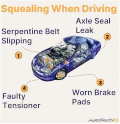
-
What is Preventative Maintenance and What Are The Benefits of it?

-
JobViewIQ - DVI Process Training - Part of the Auto Care Alliance Benefits

-
7 Signs of AC Pulley Issues
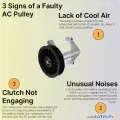
-
7 Signs of Clogged AC Components
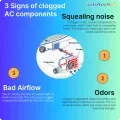
-
How Much Does a Transmission Fluid Change Cost?

-
7 Signs of a Leaking Axle Seal
